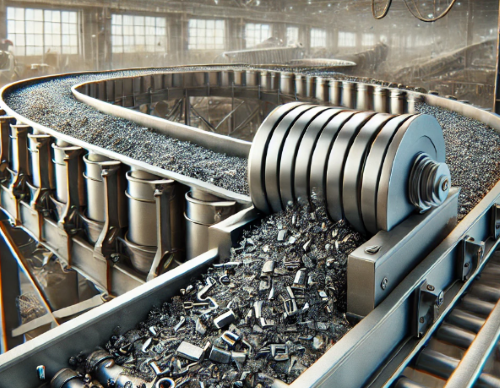Introduction to Magnetic Pulley Separators
Introduction
Magnetic pulley separators play a critical role in industries where separating ferrous materials from non-ferrous materials is essential. They are highly efficient magnetic separation tools used in industries such as recycling, mining, construction, and food processing to improve product quality, ensure safety, and maintain equipment. This article explores the fundamentals of magnetic pulley separators, how they work, and their industrial applications.
What Is a Magnetic Pulley Separator?
A magnetic pulley separator is a conveyor belt system component designed to remove ferrous metals from a material stream. It consists of a pulley magnetized with either permanent magnets or electromagnets. Installed at the discharge end of a conveyor belt, it automatically attracts and removes ferrous particles, such as iron and steel, as materials pass through the conveyor system.

How Do Magnetic Pulley Separators Work?
The operating principle of magnetic pulley separators is relatively straightforward but highly effective.
- The separator is installed as the head pulley of a conveyor belt system. As the conveyor transports material, the magnetic field of the pulley attracts any ferrous metals present in the material flow.
- These metal contaminants are held against the conveyor belt and moved along with it until the belt reaches the end of the pulley.
- Once past the pulley’s magnetic field, the ferrous materials fall off into a separate collection area or bin. Non-magnetic materials, on the other hand, simply continue their path and discharge normally. The result is a clean separation of ferrous metals from non-ferrous materials.
Types of Magnetic Pulley Separators
Magnetic pulley separators come in two primary types:
- Permanent Magnetic Pulley Separator: These utilize permanent magnets, typically made from neodymium, ferrite, or rare earth materials, to generate a consistent magnetic field without requiring an external power source. Permanent magnetic pulleys are highly reliable, with minimal maintenance required. They are suitable for applications where continuous, low-cost operation is critical.
- Electromagnetic Pulley Separator: This type uses an electric current to create a strong magnetic field, making it more suitable for handling larger or more challenging ferrous material loads. While more powerful than permanent magnetic pulleys, electromagnets require a constant power supply, which adds to operational costs but provides stronger magnetic separation capabilities in more demanding applications.
Key Benefits of Magnetic Pulley Separators
Magnetic pulley separators offer several advantages in industrial applications, making them a popular choice for ferrous metal separation:
– Efficiency: Magnetic pulley separators provide continuous and automatic separation of ferrous materials, reducing the need for manual sorting and improving overall efficiency.
– Low Maintenance: Permanent magnetic pulleys require minimal maintenance since they do not rely on an external power source, making them cost-effective over time.
– Versatility: These separators can be integrated into existing conveyor systems, offering flexibility for various industries such as mining, food processing, and recycling.
– Improved Product Quality: By removing ferrous contaminants, magnetic pulley separators enhance the quality of the processed materials, whether they are destined for manufacturing, packaging, or distribution.
– Protection of Equipment: Removing ferrous debris protects downstream equipment from damage, reducing wear and tear, extending equipment life, and minimizing costly repairs.
Industrial Applications of Magnetic Pulley Separators
Magnetic pulley separators are widely used in several industries where ferrous material separation is a vital step in the process:
- Recycling: Magnetic pulley separators are critical in the recycling industry for sorting and recovering ferrous metals from waste streams. They are commonly used in scrap metal processing, where steel and iron must be separated from other materials like plastics, glass, and aluminum.
- Mining and Mineral Processing: In the mining sector, magnetic pulley separators are employed to remove tramp iron and other ferrous contaminants from raw materials such as ores, coal, and minerals. This ensures the purity of the extracted materials and protects crushing and grinding machinery from damage.
- Food Processing: Ensuring the safety of food products is a top priority in the food processing industry. Magnetic pulley separators are used to remove ferrous metal contaminants from foodstuffs like grains, spices, and flour, which could otherwise pose health risks to consumers or damage processing equipment.
- Construction and Demolition: In the construction and demolition industry, magnetic pulley separators are used to recover ferrous metals from debris and waste materials. This not only reduces the volume of waste sent to landfills but also allows for the recycling of valuable metals like steel.
- Wood Processing: The wood industry uses magnetic pulley separators to remove nails, screws, and other ferrous metals from wood chips and other materials before they are processed into paper, furniture, or other wood products.
Conclusion
Magnetic pulley separators are indispensable tools in industries where ferrous contamination needs to be efficiently removed from material streams. Their simplicity, reliability, and low maintenance requirements make them highly effective in a variety of applications, from recycling and mining to food processing and construction. Whether using a permanent or electromagnetic pulley, these separators help improve product quality, protect equipment, and contribute to sustainable practices by facilitating the recycling of valuable metals. For more information, please check Stanford Magnets.